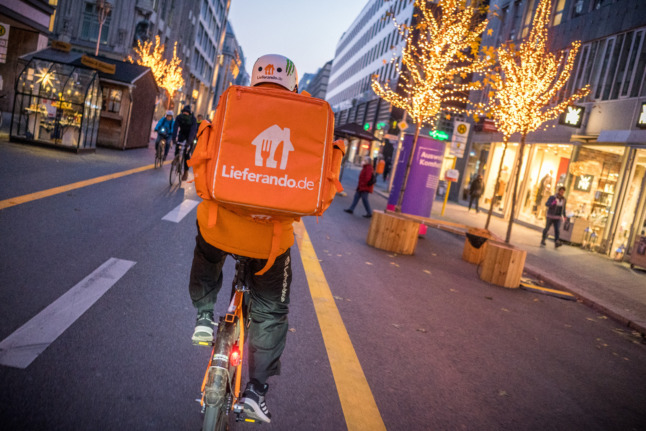From translation tools to weather forecasts, and route planners to vegan food recommendations, these apps will help you make the most of your time in Germany this summer.
Please note: links here are to the websites. You can download the apps from your usual app store.
Deutsches Wetterdienst (DWD) WarnWetter
Knowing what the weather’s going to do on any given day is always useful, not least because Germany can switch from glorious sunshine to torrential rain in a single day. Germany national weather forecaster has a trusted app that gives weather warnings.
The app gives details on the latest official weather warnings, covering everything from heatwaves and high temperatures to forest fires and flooding. Germany has some serious weather which can put lives at risk, so it’s a good idea to be aware if a warning is issued.
You can also check basic lake, coastal and flood warnings for each area – right down to municipalities – via the app, and set up notifications to get alerted about the risk of bad weather in your area.
Alternatively, you can try the Nina app for emergency warnings.
But you’ll need the paid version if you want all the bells and whistles, including current weather forecasts for your areas. This is because DWD is limited by law in what it can offer in the free version.
The app costs a one-off fee of €2.49 and for that, you’ll also get a lot of extra information, including forecasts up to seven days in advance for each of Germany’s states.
It also differentiates precipitation by rain, snow, sleet and hail, and gives wind, temperature and pollen count predictions.
But if you just want a free-to-use app to check out what the weather is expected to do on a given day (you can get forecasts up to 16 days ahead), then you might prefer the WetterOnline app.
Advertisement
It uses DWD and other data, is very easy to use and it’s free, unless you want to ditch the ads.
If you’re going to be travelling by train in Germany – and you probably are, it’s a great way to see the country – then the DB Navigator app will come in handy.
It’s the official Deutsche Bahn travel app and covers information for all of Germany’s trains, from ICE to regional trains, plus trams, underground and buses.

A woman opens up the DB Navigator app while standing in a train station. Photo: picture alliance/dpa | Jan Woitas
You’ll also be able to book your tickets, check for real-time updates, such as delays, platform changes and seat availability, and even avoid on-board seat inspections on some routes by checking in on the app (Komfort Check-in).
This handy map app from the tyre manufacturer and food critic does everything other map apps do – and also estimates how much your planned journey will cost in fuel, time, and any tolls.
READ ALSO: Germany’s highest rated restaurants to eat at this year
Advertisement
If you prefer road to rail, then FlixBus offers a similar service to the train apps, but for buses.
You can easily and cheaply book tickets to travel across Germany – and beyond, it operates in over 40 countries – whether you’re just booking a short hop or a cross-country bus-a-thon.
Germany loves its bikes. If you, too, want to take up your place in the country’s many cycle lanes, but don’t want the hassle and cost of buying a bike, then you might want to rent one instead.
NextBike is a bike-sharing scheme that makes the process pretty simple. It’s free to register (with a €1 deposit) and you can see where all the available bikes are in the app.
You’re likely to find bike hubs in most of the country as NextBike is active in more than 150 cities in Germany.
Wandern is also big news in Germany and Germans are very keen hikers. If you want to get a taste of the national pastime and the country’s over 300,000 kilometres of marked trails across a variety of terrains, then the Komoot app is a great starting point.

Hiking can be a good idea to avoid the summer heat. Photo by Jake Melara on Unsplash
It’s a bit like Strava for all outdoor pursuits, not just cycling, but without the competitive element. Plus it works better offline, too.
Advertisement
But it’s not just for hiking. You can also plan bike rides, runs or even cross-country ski routes and see what’s nearby, like cafes, if you need a pitstop.
The free version gives you access to a single region.
Being vegan in Germany is certainly not as tricky as it used to be, but it can still take some research to find where you can go to eat if you’re after fully vegan and vegetarian dishes.
That’s where HappyCow comes in. It shows plant-based, veggie and gluten-free options at non-vegan restaurants, often with helpful user reviews.
It’s particularly good in big cities, which tend to have more food variety anyway.
READ ALSO: Six apps to help you save money in your daily life in Germany
SunSmart Global UV was developed by Australia’s Cancer Council Victoria, in collaboration with the WHO and other international bodies, to help reduce skin cancer incidence.
It provides daily UV index readings – and five-day forecasts – helping users stay safe in the sun by giving advice on when to slather some more sun cream on.
Speaking of food, if you fancy getting food, groceries or basics delivered to you, then Lieferando is the largest and arguably most popular of the delivery apps in the country (there’s also Uber Eats but Lieferando’s bigger).
It’s got a wide range of fast food restaurants and shops – including supermarkets – across the country and you can track your delivery to make sure it doesn’t go astray.

Photo: picture alliance/dpa | Michael Kappeler
If you’re visiting Berlin there are a few specific travel apps you might also find helpful:
Advertisement
Run by Berlin transport operator, BVG Fahrinfo is a helpful tool for easily navigating the capital providing you’re mainly using the underground, buses, trams and ferries to get about.
Its best feature is the ability to buy and store tickets (for yourself and others) in the app, allowing you to avoid queuing at ticket machines in stations.
But it doesn’t cover all of Berlin’s transport options (see below).
It also offers real-time updates and a route-planner, but Citymapper and Öffi tend to be much easier to use for real-time journey-planning.
Both are available in most big cities in Germany, but open-source app Öffi is only on Android.
Of course, many visitors and Berlin residents simply stick to Google Maps for navigation, but it’s worth noting that Google Maps is not always up-to-date when there are transportation disruptions.
If you want to travel in the city and its surrounding areas, out to Potsdam, for example, then the VBB app gives you broader coverage and more flexible ticket options than BVG Fahrinfo.
Unlike BVG, it also covers all forms of transport, including BVG transport, but also Deutsche Bahn trains, Berlin’s S-Bahn and other private operators.
In Berlin, the Jelbi app is more widely used than NextBike. It’s run by VBG and essentially amalgamates all of Berlin’s transport options into one easy-to-use app to help you get around the city.
So you can rent bikes and e-scooters, book car shares and taxis and buy public transport tickets all in the same app.
… and a couple of language options
Translation apps still aren’t as good as knowing a language well enough to hold a conversation, but for the basics of day-to-day living, they’ll do just fine. With Google Translate, you can take a picture of a sign – or, say, a menu – on your phone and a translation will appear in your preferred language.
The much-touted conversation feature – which is supposed to be able to automatically identify spoken language – is still very much a work in progress, by all accounts, but a little lateral thinking will get your by.
British consumer watchdog Which? recently found it – and rival translation tool DeepL – were the most accurate of four big language apps tested (the others were Microsoft and Apple).
DeepL, it said, was better on colloquial language you might encounter – but the sheer number of languages available on Google, and the fact it works offline, counts in the internet giant’s favour.
Both Google Translate and DeepL are, it has to be said, pretty good with German.
Advertisement
You can get by with conversations via translation app, but nothing beats being able to hold a conversation in the local language.
And if you don’t mind being emotionally abused by an imaginary owl, then Duolingo will help you do that.
We’re not about to suggest Duolingo will get you from zero to fluent in a matter of weeks (if learning German was that easy, everyone would do it), but you’ll gradually pick up more and more without referring to your translation app, or heading off in the wrong direction after listening to a slew of indecipherable directions from a Bavarian.
A couple other language learning apps to try include Babbel and Pingo AI.
Did we miss any need-to-have apps to make the most of life in Germany? Let us know in the comments below.
